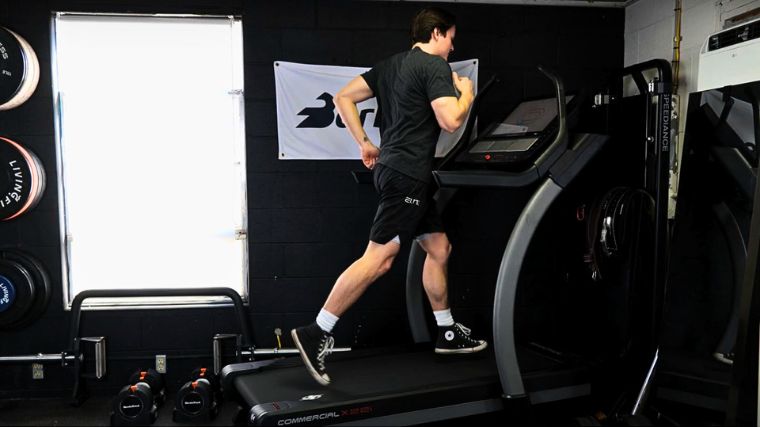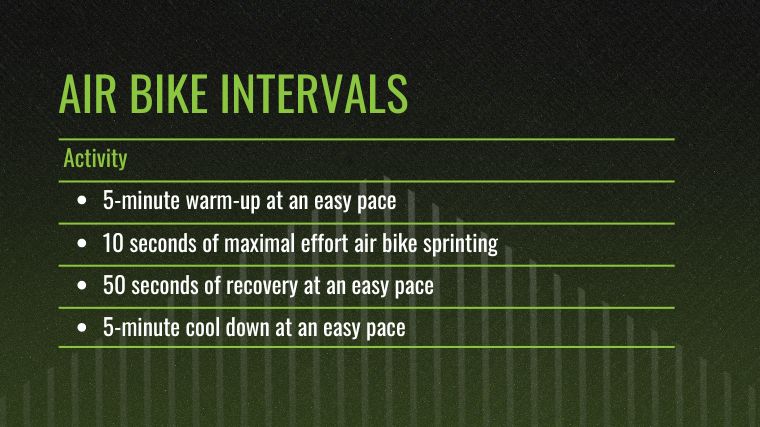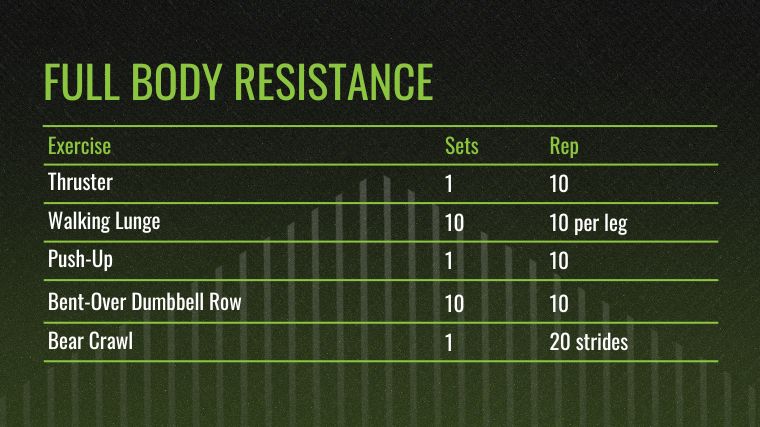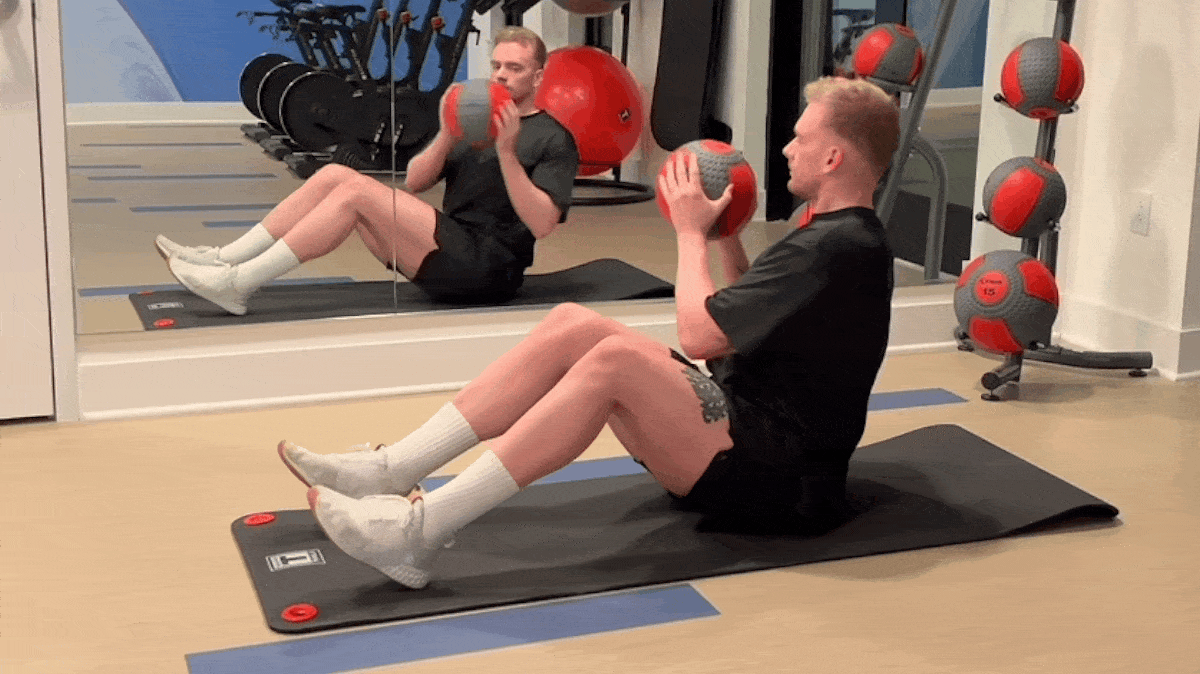Even if you live and breathe for barbells and weight plates, cardiovascular training has got to play a role in your program. Not only does it support your aerobic system for general health, but it also builds your capacity to recover between hard sets of strength training.

If you’ve ever felt like you were sucking wind for far too long between lifts, interval training is a great prescription. You’ll use short bursts of high-intensity exercise and minimal rest periods. The goal is to crank your heart rate and condense as much work as possible into a short amount of time. Here’s how to arrange all that into the best interval training workouts.
The Best Interval Training Workouts
- Air Bike Intervals
- Treadmill Running
- Functional Implement Circuit
- Full-Body Resistance
- Hybrid Circuits
Air Bike Intervals
High-intensity interval training (HIIT) is perhaps the most popular type of interval training—and you can’t get a much higher intensity than you can on the air bike. Sometimes referred to as an assault bike, the air bike is a huge challenge for athletes at every fitness level. (There’s a reason these bikes pop up so much at the CrossFit Games.) Even used slowly, the air bike is bound to give you a truly heart-pumping ride.
The Workout
The air bike produces wind resistance via a fan blade (similar to a rowing ergometer) so that you’re not just pedaling with your legs, but also cranking your arms. This makes the air bike a scalable full-body workout where the more you exert yourself, the more resistance you create. If you’re trying to challenge your cardiovascular system as fast as possible, air bike intervals are for you.
It’ll give you all the benefits of HIIT training, cram in an intense cardio workout into just a few minutes, and will help you burn calories at a high rate if that’s something you’re after.

- 5-minute warm-up at an easy pace
- 10 seconds of maximal effort air bike sprinting
- 50 seconds of recovery at an easy pace
- 5-minute cool down at an easy pace
Note: Repeat this work cycle 5-10 times, starting with fewer interval repeats and building up throughout several workouts.
Coach’s Tip: This is an extremely challenging workout. Make sure you are going all-out during the intervals and recovering as much as possible in between. Breathe!
How Often to Do This Workout: This exercise routine is extremely intense. I recommend that clients only perform air bike intervals 1-2 times per week at most.
Modifications
- Make it Easier: The main way to make the air bike easier is to extend your interval time and use a slower pace. Aim for 15-20 seconds of work and 60-90 seconds of rest.
- Make it Harder: Try alternating how much you emphasize the pedals or arm resistance per interval. Go primarily lower body on one followed by primarily upper body effort on the next.
Treadmill Running
Sure, you can hit the track and run with no equipment but your running shoes. But if you want to stay indoors, treadmill running is another style of cardio that you can use for lower-intensity training and higher-intensity interval training. If you’ve historically erred on the side of moderate-intensity or steady-state jogging, you might be be surprised what breathtaking anaerobic and aerobic exercise the treadmill can offer.
The Workout
Treadmill sprints are designed to be short bursts of high-intensity effort followed by short periods of recovery. There are certain treadmills that make performing your sprints a lot easier, such as the arc style of a manual treadmill. These are completely manually driven and react to your sprinting pace almost instantly instead of a motor needing to ramp up.

- 5-minute warm-up jog
- 15 seconds of hard running
- 45 seconds of recovery using an easy jog or walking pace
- 10-minute cool down at an easy pace
Note: Repeat this working cycle 5-10 times. Starting with fewer interval repeats and building up over the course of several workouts.
Coach’s Tip: Try setting a timer on your watch or smartphone and setting up your intervals outside!
How Often to Do This Workout: Treadmill running (especially using intervals) is another potentially taxing workout. This is not a low-impact workout. Instead, the repeated impacts from your strides may cause some soreness the next day. Try adding just 1-2 of these per week.
Modifications
- Make it Easier: Instead of five to 10 consistent max effort sprints, change things up with various work to rest ratios throughout the workout.
- Make it Harder: One of the easiest but most challenging ways to make treadmill sprints harder is to add an incline to your run. Be careful of your footing!
Functional Implement Circuit
You don’t need cardio machines to put your aerobic system on full alert. Using anaerobic styles of resistance training in combination with weighted cardio tools like a sled is a great way to change things up. The health benefits of these kinds of workouts can include increased motivation, too—if you have more fun mixing up your workout styles and not just keeping things static, this will boost your overall wellness by giving you that extra burst of fun.
The Workout
Combining different explosive and strength moves with a cardiovascular style of exercise within the same workout is a fantastic way to interval train. Using medicine balls, sled pushes, and lunges is a highly effective way to revamp more traditional workouts. You may well find yourself farther along in your mission to build muscle or drive weight loss after integrating this one into your program.

- Medicine Ball Slam: 1 x 10 repetitions
- Sled Push: 1 x 20 total steps
- Goblet Reverse Lunge: 1 x 10 repetitions per leg
- Sled Push: 1 x 20 total steps
- Medicine Ball Slam: 1 x 10 repetitions
Note: Perform this circuit 5 times, resting as needed between completed rounds.
Coach’s Tip: This workout is extremely scalable. I often push clients to load up the sled or reverse lunge progressively over time to keep the workout challenging.
How Often to Do This Workout: Like many interval workouts, this one is high intensity. It also employs many resistance training aspects too, meaning you’ll likely be sore. Try completing it twice per week.
Modifications
- Make it Easier: Change up the sled push to a reverse sled drag—it may make breathing easier during the exercise compared to the sled push counterpart.
- Make it Harder: This one is about as blunt as they come: load up the sled push and goblet reverse lunge and the workout never gets “easier.”
Full-Body Resistance
Circuit training is where you string together several resistance exercises in a row to maximize the work you perform in a short amount of time. This may be a combination of upper or lower-body exercises. Whatever your emphasis, the more seamlessly you can string them together the better. Minimal rest and transition time between exercises keeps your heart rate high.
The Workout
Full-body resistance exercises are a massive challenge to your heart and skeletal muscles. Exercises that involve a strong core brace restrict deep breathing and challenge your cardiovascular system that much more. The squat, lunge, pressing, and pulling patterns are amazing tools here.

- Thruster: 1 x 10 repetitions
- Walking Lunge: 1 x 10 repetitions per leg
- Push-Up: 1 x 10 repetitions
- Bent-Over Dumbbell Row: 1 x 10 repetitions
- Bear Crawl: 1 x 20 total strides
Note: Perform as many circuits as possible within 30 minutes.
Coach’s Tip: Make sure to set up your dumbbells or appropriate resistance in advance for easy transitions between exercises. Also, clear your workout area to be mindful of other trainees or your space required to safely execute certain moves.
How Often to Do This Workout: Resistance training intervals such as circuit training is a double-edged sword because you should expect soreness after the fact. Aim for 2-3 circuit-style interval training workouts per week if it’s your main focus.
Modifications
- Make it Easier: Any exercise has a convenient swap to help scale the challenge. For example, perform goblet squats instead of thrusters, push-ups from the knee, or loaded carries for the bear crawl.
- Make it Harder: Try performing your walking lunges with a double kettlebell rack position style. This immediately increases core engagement and makes breathing more difficult as well.
Hybrid Circuits
Hybrid circuits intentionally combine resistance training and traditional cardio moves into one workout. Stringing together a few key resistance training movements helps directly stimulate key muscles; then the end-of-circuit cardio finishes off each circuit.
The Workout
Get creative with your hybrid circuits, as they have a great capacity for variation. The aim should be full-body movements that involve a ton of muscle and core engagement followed by some high-effort cardio for calorie burn and heart rate management.

- Single-Arm Dumbbell Snatch: 1 x 5 repetitions per side
- Alternating Dumbbell Z-Press: 1 x 10 repetitions per arm
- Dumbbell Russian Twist: 1 x 20 total repetitions
- Burpee: 1 x 10 repetitions
- Rower Sprint: 1 x 30 seconds
Note: Repeat this circuit as many times as possible within 20-30 minutes.
Coach’s Tip: Be sure to have solid technique on all of your movements, particularly the dumbbell snatch. This means allowing a good amount of recovery between rounds. Consider having a personal trainer check your form if possible.
How Often to Do This Workout: Do this workout 1-2 times per week and test yourself against your previous performances.
Modifications
- Make it Easier: This circuit is scalable by removing some of the more explosive aspects and choosing moves that give you more control. Try changing the single-arm snatch into an upright row-squat combination instead.
- Make it Harder: Modifications are your friend here, too. Add a push-up to each burpee and do one side at a time on your Z-press instead of alternating it.
What Is Interval Training?
Interval training is the combination of structured high-intensity effort with intentional recovery time between bursts. This means performing 10 to 30 seconds of hard cardio followed by a minute of rest or a full series of three to five resistance exercises without rest. Do that all before taking a minute off.
Interval training is designed to harness as much muscle as possible and use high-intensity or explosive movements to crank your heart rate.
Another way to think of interval training is using your anaerobic system to train your aerobic system. How hard are you able to work, and how quickly are you able to recover?
What Are the Benefits of Interval Training?
Interval training is an extremely efficient way of exercising, some of the core benefits include:
- Improved anaerobic conditioning
- Improved aerobic recovery
- Improved blood pressure
- Build full-body strength and conditioning
- Build full-body muscular endurance
- Fun alternative to traditional cardiovascular training
- High calorie burn
Interval Training Vs. HIIT
Interval training and high-intensity interval training (HIIT) are close neighbors and often used interchangeably; however, they are unique. Interval training is the simple structuring of work versus rest windows during a workout and fits any combination of intensity levels.
HIIT, on the other hand, is designed to produce maximum heart rates with minimal recovery periods. Good examples of HIIT are sprint interval training or Tabata training, which are typically much shorter bursts of the highest intensity activity possible.
Can Beginners Do Interval Training?
The beauty of interval training is that it’s completely scalable to your individual workout needs, goals, available equipment, or capabilities. Here’s how you can get into it as a newbie.
Start Slow
Interval training doesn’t always need to look like HIIT or sprint interval training. Sure, you’re going to aim for structured work and rest periods, but you are certainly able to choose more moderate-intensity intervals to start. Ease in with one to two sessions per week using more modest intensity or duration workouts to get the hang of it.
Get Creative
One of the biggest assets of interval training is that you can use whatever equipment (or lack thereof) that you have at your disposal. From cardiovascular machine work to highly variable calisthenic or free-weight circuits, no two interval training sessions need to look the same.

Either find new and engaging ways to challenge yourself or create a few personal benchmark workouts to test your improvements over time.
Build Over Time
The frequency, duration, or even length of each circuit that you perform during an interval workout should also build over time. If you’re a beginner, simply test the waters. As you establish a base, you’ll then be able to build in either more exercises, more rounds, or increased frequency per week until you find your sweet spot.
Frequently Asked Questions
Interval training is an extremely popular form of workout. Here are some frequently asked questions on the training style.
Is 20 minutes of interval training enough?
Twenty minutes is absolutely enough time for interval training. Some of the more cardio-dominant forms such as the air bike or treadmill fit especially well into a 20-minute pocket, leaving you completely soaked in sweat in the process.
What is the 4-30-10 method workout?
The 4-30-10 method of working out is a guideline for four workouts per week, approximately 20 to 30 minutes per session, with a daily step-count goal of 10,000. This helps take the guesswork out of your programming and places extreme management benchmarks for your overall workouts when you’re getting started.
How many calories can I burn in a 20-minute HIIT workout?
This is an extremely variable answer as it is heavily impacted by workout style, equipment or exercise selection, and intensity throughout the workout. Generally speaking, you might bank on 100 to 300 calories per 20-minute HIIT session. However, this should not be taken as a guarantee. Without solid tracking technology and an individualized perspective, it’s next to impossible to accurately predict calories burned. Try a fitness monitor to get an idea of your ballpark.
Editor’s Note: The content on BarBend is meant to be informative in nature, but it should not be taken as medical advice. When starting a new training regimen and/or diet, it is always a good idea to consult with a trusted medical professional. We are not a medical resource. The opinions and articles on this site are not intended for use as diagnosis, prevention, and/or treatment of health problems. They are not substitutes for consulting a qualified medical professional.